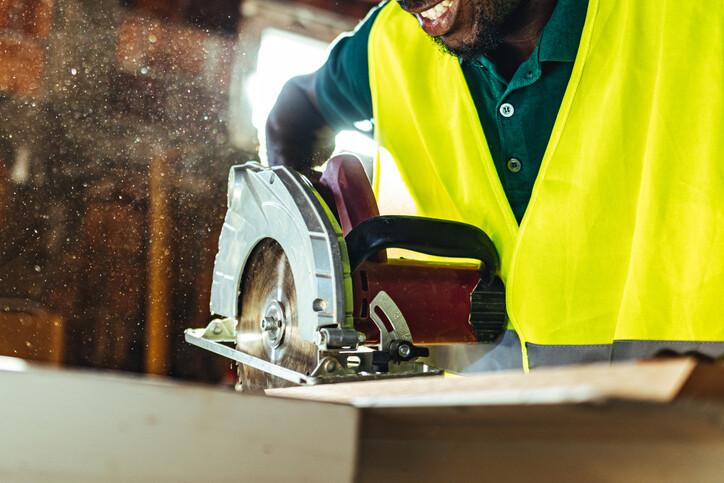 Understanding which saw to use can significantly impact the safety and outcome of your work. At Paragon Tool Hire, we pride ourselves on supplying high-quality tools for a wide range of construction and DIY projects. Our extensive inventory is designed to meet the diverse needs of our clients, ensuring that every task, big or small, is undertaken efficiently. We understand the importance of selecting the right saw for each project. Let us walk you through the various types of saws available, and provide you with important safety tips so that you can work confidently.
Understanding which saw to use can significantly impact the safety and outcome of your work. At Paragon Tool Hire, we pride ourselves on supplying high-quality tools for a wide range of construction and DIY projects. Our extensive inventory is designed to meet the diverse needs of our clients, ensuring that every task, big or small, is undertaken efficiently. We understand the importance of selecting the right saw for each project. Let us walk you through the various types of saws available, and provide you with important safety tips so that you can work confidently.
Choosing the Right Saw
Saws come in many shapes and sizes, each designed for specific materials and purposes. In both construction and DIY projects, choosing the right saw makes a significant difference. Some saws are built for making quick, straight cuts, while others are better suited for more intricate work. Understanding the variety of saws available will help you pick the best one for your project.
Types of Saws and Their Uses
Circular Saws
Great for straight cuts in wood ideal for carpentry and framing. With a range of blade sizes and types available, circular saws are excellent for tasks requiring speed and accuracy.
Cut-Off Saws
Perfect for cutting through tough materials like metal and concrete. Cut-off saws are commonly used in construction and demolition projects in the field where heavy-duty power cutting is essential.
Door Saws
Specifically designed for trimming and cutting doors to size. A door saw ensures clean, precise cuts, allowing the door to fit perfectly without having to remove and re-hang the door.
Floor Saws
Primarily used for cutting concrete, and asphalt during construction work. Equipped with diamond-tipped blades, floor saws can handle the toughest surfaces with precision.
Jigsaws
Suitable for curved and intricate cuts in wood, metal or plastic. The small, easily controlled blade allows for precision when working on complex shapes or tight corners.
Masonry Saws
Designed for repetitive high cycle cutting of brick, stone and other masonry materials. With diamond-tipped blades and water-cooling systems to prevent overheating, they deliver clean, accurate cuts in even the most stubborn materials.
Mitre Saws
Ideal for precision angled cuts, especially when working with wood. Commonly used in trim work, framing and moulding, mitre saws allow you to make accurate cuts at various angles.
Reciprocating Saws
Versatile saw for demolition work, suitable for cutting through wood, metal or plaster. These saws are often used in renovation projects where walls or structures need to be torn down.
Wall Chasing Machines & Wall Cutters
Efficient for creating channels for electrical wiring or pipes in walls. These machines make it easy to cut clean, straight lines in concrete, brick or plaster, helping to speed up installation times for electricians and plumbers.
Splitters
A specialised tool for splitting large logs or stone materials. Splitters are particularly useful in landscaping and stone masonry, providing an efficient way to break down bulky materials.
Professional Saw Accessories
Choosing the right saw is only part of the equation. To ensure the best possible performance - and safety - it’s equally as important to pair your saw with the right accessories.
- Blades. The right blade is essential for achieving clean, precise cuts.
- Cutting guides. Attachments that help maintain straight or angled cuts, especially useful for circular and mitre saws.
- Protective gear. Safety should always come first. PPE such as gloves, goggles and ear protection ensure that you can work safely.
- Dust extraction systems and water suppression. Saws generate a lot of dust, especially when cutting materials like concrete or drywall. Both dust extraction and water suppression can help maintain a clean workspace and reduce inhalation risks.
Safety Tips for Using Saws
Using any power tool requires caution. Some safety tips to keep in mind include:
- Kickback: One of the most dangerous risks when using a saw, kickback occurs when the saw blade gets stuck or pinched in the material, causing it to lurch backwards towards the operator. Always maintain a firm grip and avoid forcing the saw through the material.
- Blade exposure: Ensure the blade is fully guarded when not in use. Never touch the blade while it’s spinning and always turn off and unplug the saw before changing the blade.
- Dust: Saws generate fine dust that can be harmful when inhaled. Always wear a dust mask and use dust extraction systems wherever possible.
- PPE: Personal protective equipment (PPE) is non-negotiable when using saws. Always wear gloves, goggles, ear protection and a dust mask to protect yourself from flying debris and loud noise.
- Equipment checks: Regularly inspect the saw and accessories for damage or wear. When hiring a saw from Paragon Tool Hire, you can rest assured that all of our equipment undergoes rigorous safety checks.
- Manufacturer’s guidelines: Always follow the manufacturer’s guidelines for the specific saw you’re using. If unsure, please seek our expert advice.
Choosing the right saw can make all the difference
Choosing the right saw for your project can make all the difference in terms of efficiency and safety. Whether you’re cutting wood, metal or any other material, there’s a saw designed perfectly for the job. At Paragon Tool Hire, we provide a wide range of high-quality tools, as well as the expert advice you need to make the right choice. Contact our friendly team today on 01280 822282 for guidance.
